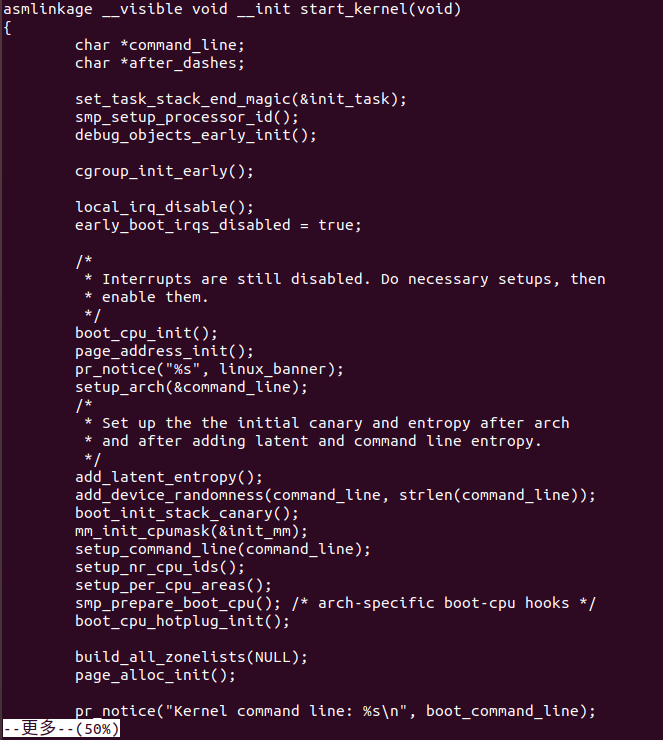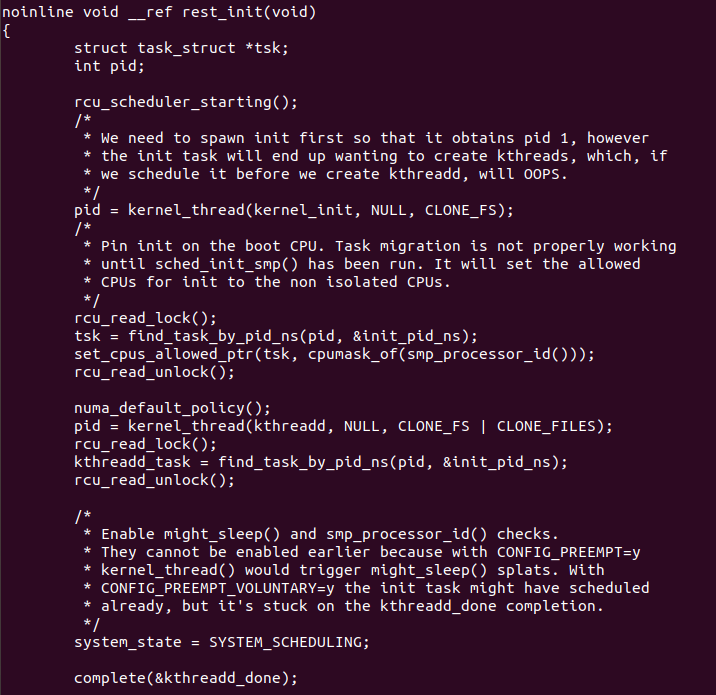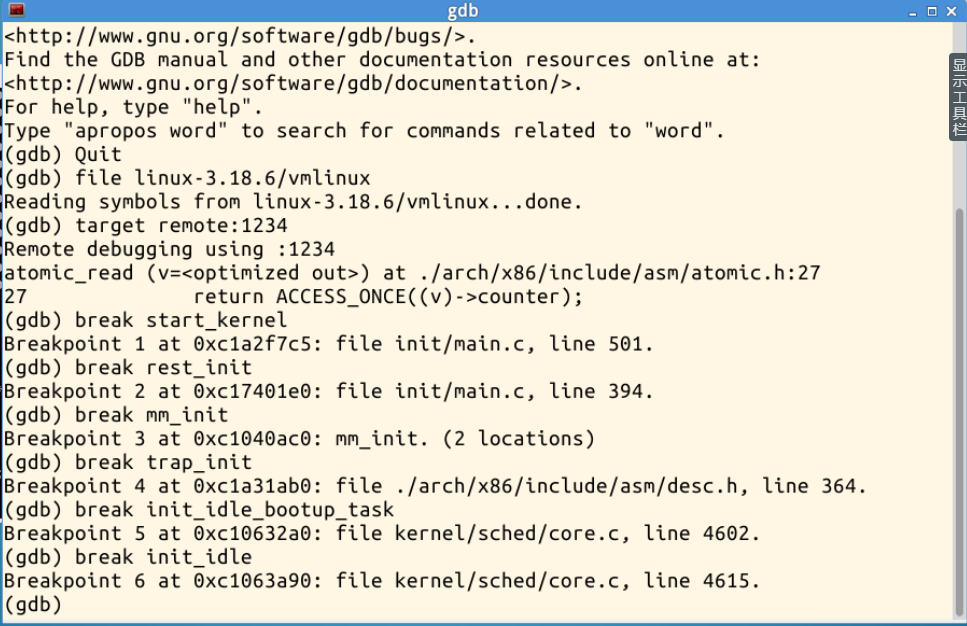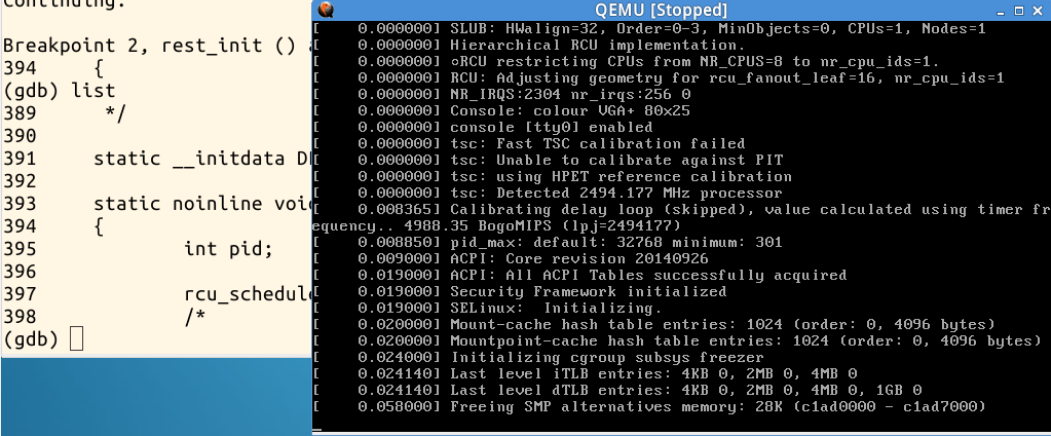2018-2019-1 20189221《Linux核心原理與分析》第四周作業
阿新 • • 發佈:2018-11-01
2018-2019-1 20189221《Linux核心原理與分析》第四周作業
教材學習:《庖丁解牛Linux核心分析》
第 3 章 MenuOS的構造
計算機三大法寶:儲存程式計算機,函式呼叫堆疊,中斷
作業系統兩把寶劍:中斷上下文,程序上下文
Linux核心原始碼:
Linux核心使用的是第二週時下載的Linux-2.6版本
Linux核心目錄:

init目錄下的main.c函式:

start_kernel():

init_task():

rest_init():

隨書學習很有收穫,也算是為實驗操作做了很多準備。
實驗報告:實驗 3 跟蹤分析Linux核心的啟動過程
實驗流程
使用實驗樓的虛擬機器開啟shell,核心啟動完成後進入menu程式


使用gdb跟蹤除錯核心
gdb
(gdb)file linux-3.18.6/vmlinux # 在gdb介面中targe remote之前載入符號表
(gdb)target remote:1234 # 建立gdb和gdbserver之間的連線,按c 讓qemu上的Linux繼續執行
(gdb)break start_kernel # 斷點的設定可以在target remote之前,也可以在之後
設定斷點:

使用list檢視斷點臨近程式碼:

除錯過程中:

程式碼分析
start_kernel()程式碼:
asmlinkage __visible void __init start_kernel(void) { char *command_line; char *after_dashes; lockdep_init(); set_task_stack_end_magic(&init_task); smp_setup_processor_id(); debug_objects_early_init(); boot_init_stack_canary(); cgroup_init_early(); local_irq_disable(); early_boot_irqs_disabled = true; /* * Interrupts are still disabled. Do necessary setups, then * enable them */ boot_cpu_init(); page_address_init(); pr_notice("%s", linux_banner); setup_arch(&command_line); mm_init_cpumask(&init_mm); setup_command_line(command_line); setup_nr_cpu_ids(); setup_per_cpu_areas(); smp_prepare_boot_cpu(); /* arch-specific boot-cpu hooks */ build_all_zonelists(NULL, NULL); page_alloc_init(); pr_notice("Kernel command line: %s\n", boot_command_line); parse_early_param(); after_dashes = parse_args("Booting kernel", static_command_line, __start___param, __stop___param - __start___param, -1, -1, &unknown_bootoption); if (!IS_ERR_OR_NULL(after_dashes)) parse_args("Setting init args", after_dashes, NULL, 0, -1, -1, set_init_arg); jump_label_init(); /* * These use large bootmem allocations and must precede * kmem_cache_init() */ setup_log_buf(0); pidhash_init(); vfs_caches_init_early(); sort_main_extable(); trap_init(); mm_init(); /* * Set up the scheduler prior starting any interrupts (such as the * timer interrupt). Full topology setup happens at smp_init() * time - but meanwhile we still have a functioning scheduler. */ sched_init(); * Disable preemption - early bootup scheduling is extremely * fragile until we cpu_idle() for the first time. */ preempt_disable(); if (WARN(!irqs_disabled(), "Interrupts were enabled *very* early, fixing it\n")) local_irq_disable(); idr_init_cache(); rcu_init(); context_tracking_init(); radix_tree_init(); /* init some links before init_ISA_irqs() */ early_irq_init(); init_IRQ(); tick_init(); rcu_init_nohz(); init_timers(); hrtimers_init(); softirq_init(); timekeeping_init(); time_init(); sched_clock_postinit(); perf_event_init(); profile_init(); call_function_init(); WARN(!irqs_disabled(), "Interrupts were enabled early\n"); early_boot_irqs_disabled = false; local_irq_enable(); kmem_cache_init_late(); /* * HACK ALERT! This is early. We're enabling the console before * we've done PCI setups etc, and console_init() must be aware of * this. But we do want output early, in case something goes wrong. */ console_init(); if (panic_later) panic("Too many boot %s vars at `%s'", panic_later, panic_param); lockdep_info(); /* * Need to run this when irqs are enabled, because it wants * to self-test [hard/soft]-irqs on/off lock inversion bugs * too: */ locking_selftest(); #ifdef CONFIG_BLK_DEV_INITRD if (initrd_start && !initrd_below_start_ok && page_to_pfn(virt_to_page((void *)initrd_start)) < min_low_pfn) { pr_crit("initrd overwritten (0x%08lx < 0x%08lx) - disabling it.\n", page_to_pfn(virt_to_page((void *)initrd_start)), min_low_pfn); initrd_start = 0; } #endif page_cgroup_init(); debug_objects_mem_init(); kmemleak_init(); setup_per_cpu_pageset(); numa_policy_init(); if (late_time_init) late_time_init(); sched_clock_init(); calibrate_delay(); pidmap_init(); anon_vma_init(); acpi_early_init(); #ifdef CONFIG_X86 /*與x86硬體相關程式碼 如果主機板支援EFI的話*/ if (efi_enabled(EFI_RUNTIME_SERVICES)) efi_enter_virtual_mode(); #endif #ifdef CONFIG_X86_ESPFIX64 /* Should be run before the first non-init thread is created */ init_espfix_bsp(); #endif thread_info_cache_init(); cred_init(); fork_init(totalram_pages); proc_caches_init(); buffer_init(); key_init(); security_init(); dbg_late_init(); vfs_caches_init(totalram_pages); signals_init(); /* rootfs populating might need page-writeback */ page_writeback_init(); proc_root_init(); cgroup_init(); cpuset_init(); taskstats_init_early(); delayacct_init(); check_bugs(); sfi_init_late(); if (efi_enabled(EFI_RUNTIME_SERVICES)) { efi_late_init(); efi_free_boot_services(); } ftrace_init(); /* Do the rest non-__init'ed, we're now alive */ rest_init(); }
start_kernel()分析:
lockdep_init(); //死鎖檢測模組初始化
debug_objects_early_init(); //初始化堆疊 此堆疊有額外的越界保護功能
page_address_init(); //初始化頁表地址
pidhash_init(); //給新程序分配程序號
mm_init(); //初始化記憶體管理
sched_init(); //啟動排程器
radix_tree_init(); //init some links before init_ISA_irqs() //初始化中斷
rest_init()函式:
static noinline void __init_refok rest_init(void)
{
int pid;
rcu_scheduler_starting();
/*
* We need to spawn init first so that it obtains pid 1, however
* the init task will end up wanting to create kthreads, which, if
* we schedule it before we create kthreadd, will OOPS.
*/
kernel_thread(kernel_init, NULL, CLONE_FS);
numa_default_policy();
pid = kernel_thread(kthreadd, NULL, CLONE_FS | CLONE_FILES);
rcu_read_lock();
kthreadd_task = find_task_by_pid_ns(pid, &init_pid_ns);
rcu_read_unlock();
complete(&kthreadd_done);
/*
* The boot idle thread must execute schedule()
* at least once to get things moving:
*/
init_idle_bootup_task(current); /*idle初始化*/
schedule_preempt_disabled();
/* Call into cpu_idle with preempt disabled */
cpu_startup_entry(CPUHP_ONLINE);
}
rest_init()分析:
int pid; //定義程序號
kernel_thread(kernel_init, NULL, CLONE_FS); //初始化核心執行緒
本週小結
- 這周學習時間上按照計劃完成,較之之前兩週都輕鬆許多
- 這周遇到的問題不確定是怎樣的問題:
問題一:一開始實驗時,QEMU視窗無反應,點選則實驗樓的實驗環境宕機

解決:個人認為是實驗樓的原因,因為第二天我再次進行實驗時:

兩個小時之後再次嘗試實驗樓才恢復正常
